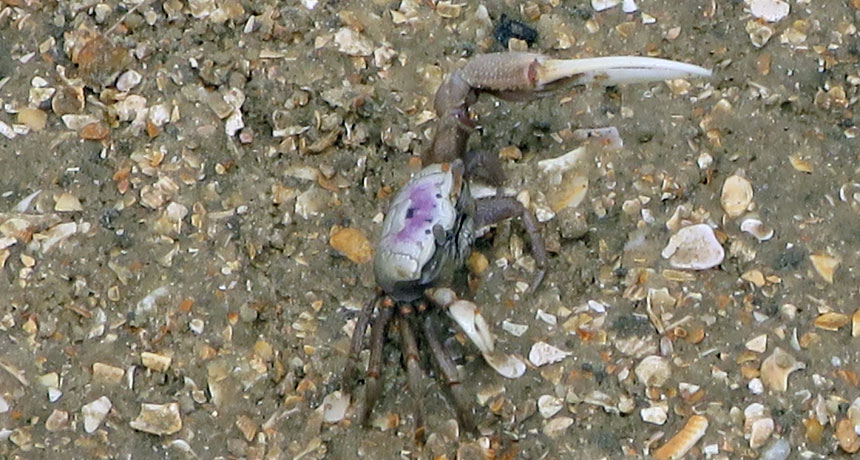A summer challenge: Observe nature

A male fiddler crab holds up his large claw as part of a dance that he uses to attract a female.
S. Zielinski
- More than 2 years ago
One morning in early April in St. Augustine, Fla., I went for a walk. My goal had been the beach, but I never made it that far. Near the house where I was staying, I passed a mudflat along the Mantanzas River, and I noticed the ground moving. But it wasn’t really the ground — there were thousands of tiny fiddler crabs dancing about in the sun. As I approached the crabs, they scuttled into their burrows. I stood still for minutes so I could catch a glimpse when the crabs crept back out into the open and start to dance again.
I’m still not sure what species of crab I saw (my best guess is Uca pugilator, the Atlantic sand fiddler crab), but I didn’t need to know the species to know what they were doing. The males were the ones with the single big claw, which each was waving about near a hole in the ground. He was trying to lure a female into his burrow to mate. It is a well-known behavior but something I had never seen before, at least not on such a vast scale.
As a science writer, I spend a lot of time immersed in the world of science, but it’s usually through journal papers and conversations with scientists. I rarely participate, and I often forget to observe what’s around me. And the dancing crabs reminded me that I may be missing something interesting.
So this is my summer challenge — and perhaps it’s yours as well: Observe nature.
On a Florida mudflat, thousands of fiddler crabs dance in the sun. (Video: S. Zielinski) |
I’m a city dweller, so that may seem difficult, at least at first. But as Kate Baggaley noted in Science News late last year, cities are brimming with wildlife, and not just rats and other pests. There are birds and mammals and insects and reptiles — you just have to keep an eye out for them. On a late night walk home a few years ago, for instance, I spotted an opossum sitting on a neighbor’s porch. I later found out from the home’s owner that it lived beneath the house and shared their cat’s food and water.
I tend to do nothing more with my observations than hold them in my memory, but this challenge is great for anyone who wants to help out and perform some citizen science. Here are some suggestions:
-
FrogWatch USA: Learn how to identify frogs and toads by their calls and help monitor local populations during breeding season (which generally occurs sometime between January and September).
-
Celebrate Urban Birds: One of several citizen science projects from the Cornell Lab of Ornithology, Celebrate Urban Birds collects data on familiar bird species, such as robins and mallard ducks from cities and other environments (including rural ones) across the United States.
-
Firefly Watch: The Museum of Science in Boston collects summer observations of fireflies — so you can turn your magical nights into scientific data.
-
Wildlife Watch: The National Wildlife Federation is collecting and sharing wildlife stories of all kinds online. The organization will use the data to track the health and behavior of animals and plants.
- Nature’s Notebook: The USA National Phenology Network wants to know more about how plants and animals are changing their seasonal timing. Which flowers are opening earlier in the spring, for instance, and are birds leaving later on their migration south? Your observations can help scientists figure that out.
Last year, researchers reported finding a new ability in rock goby fish — they could change color. What was particularly notable about the report was that the fish can be found swimming in tide pools along the southwest coast of England. Tidepooling is a common activity in that part of England, and people had surely seen those fish for hundreds of years, yet no one noticed the color-changing ability.
As I go out this summer to look around me, I’m not likely to notice a never-before-documented ability in a species, or find an entirely new species on my own. But I might get an interesting picture or video and a memorable experience, or perhaps even contribute to someone else’s discovery. And it’s always nice to remember that we don’t know everything about the world around us — and there’s always a new discovery just around the corner. We just have to keep our eyes open for it.






